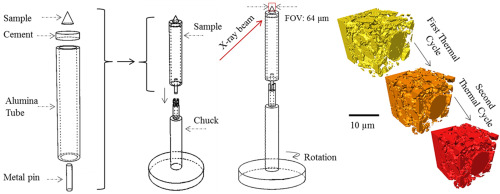Nano Energy ( IF 16.8 ) Pub Date : 2018-03-03 , DOI: 10.1016/j.nanoen.2018.03.001 T.M.M. Heenan , D.P. Finegan , B. Tjaden , X. Lu , F. Iacoviello , J. Millichamp , D.J.L. Brett , P.R. Shearing

|
Electrochemical energy devices offer a variety of alternate means for low-carbon, multi-scale energy conversion and storage. Reactions in these devices are supported by electrodes with characteristically complex microstructures. To meet the increasing capacity and lifetime demands across a range of applications, it is essential to understand microstructural evolutions at a cell and electrode level which are thought to be critical aspects influencing material and device lifetime and performance. X-ray computed tomography (CT) has become a highly employed method for non-destructive characterisation of such microstructures with high spatial resolution. However, sub-micron resolutions present significant challenges for sample preparation and handling particularly in 4D studies, (three spatial dimensions plus time). Here, microstructural information is collected from the same region of interest within two electrode materials: a solid oxide fuel cell and the positive electrode from a lithium-ion battery. Using a lab-based X-ray instrument, tomograms with sub-micron resolutions were obtained between thermal cycling. The intricate microstructural evolutions captured within these two materials provide model examples of 4D X-ray nano-CT capabilities in tracking challenging degradation mechanisms. This technique is valuable in the advancement of electrochemical research as well as broader applications for materials characterisation.
中文翻译:

使用基于实验室的X射线成像的电化学能源设备的4D纳米断层扫描
电化学能源设备为低碳,多尺度能源转换和存储提供了多种替代手段。这些设备中的反应由具有特征复杂的微观结构的电极支持。为了满足在各种应用中不断增长的容量和寿命要求,必须了解电池和电极级的微结构演变,这被认为是影响材料和器件寿命及性能的关键方面。X射线计算机断层扫描(CT)已成为一种具有高空间分辨率的无损表征此类微结构的方法。但是,亚微米分辨率对样品的制备和处理提出了巨大的挑战,尤其是在4D研究中(三个空间维度加上时间)。这里,微观结构信息是从两种电极材料中的相同关注区域收集的:固体氧化物燃料电池和锂离子电池的正极。使用基于实验室的X射线仪器,可以在热循环之间获得具有亚微米分辨率的X线断层图。在这两种材料中捕获的复杂的微观结构演变为跟踪具有挑战性的降解机理提供了4D X射线纳米CT功能的模型实例。该技术在电化学研究的进步以及材料表征的更广泛应用中具有宝贵的价值。在热循环之间获得了亚微米分辨率的X线断层图。在这两种材料中捕获的复杂的微观结构演变为跟踪具有挑战性的降解机理提供了4D X射线纳米CT功能的模型实例。该技术在电化学研究的进步以及材料表征的更广泛应用中具有宝贵的价值。在热循环之间获得了亚微米分辨率的X线断层图。在这两种材料中捕获的复杂的微观结构演变为跟踪具有挑战性的降解机理提供了4D X射线纳米CT功能的模型实例。该技术在电化学研究的进步以及材料表征的更广泛应用中具有宝贵的价值。











































 京公网安备 11010802027423号
京公网安备 11010802027423号